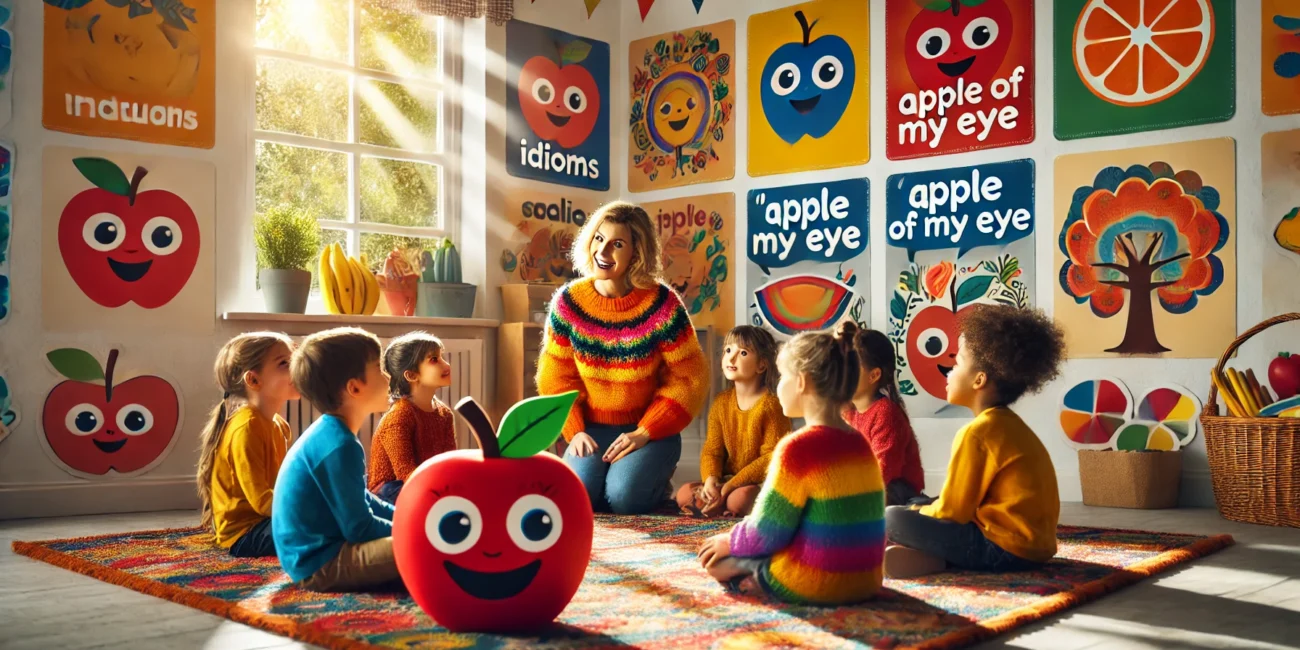To teach idioms effectively, start by choosing simple, relatable phrases like "piece of cake" that match your child's experiences. Use visual aids, such as flashcards or storyboards, to make meanings clear and fun. Incorporate games like charades and scavenger hunts to engage their creativity while reinforcing understanding. Context is key, so connect idioms to real-life situations, like using "break the ice" in a conversation. Regularly review what they've learned to strengthen retention, and celebrate their progress with rewards. With these engaging strategies, your child will develop a love for idioms and language itself, and there's even more to explore!
Key Takeaways
- Choose idioms that are age-appropriate and relatable to children's daily experiences for better understanding and engagement.
- Use visual aids like flashcards and storyboards to transform abstract idioms into comprehensible and engaging learning experiences.
- Incorporate interactive activities such as charades and scavenger hunts to reinforce the meanings and uses of idioms through play.
- Consistently review idioms through games and group discussions to solidify comprehension and encourage usage in conversation.
- Celebrate progress and encourage exploration of new idiomatic expressions to foster a love for language and enhance confidence in communication.
Understanding Idioms
Understanding idioms can be tricky for kids, but it's essential for communicating effectively. When you hear someone say, "It's raining cats and dogs," it doesn't mean literal cats and dogs are falling from the sky! This idiomatic expression simply means it's raining heavily.
Many idioms have fascinating origins, often rooted in historical context or cultural practices. For instance, the phrase "barking up the wrong tree" comes from hunting dogs mistakenly believing their target is in a tree when it isn't. When you explain idioms to kids, share these stories to spark their interest and help them remember the meanings.
Kids might get confused by idiomatic expressions since the words don't directly explain the ideas. To help, use vivid images and real-life examples where these expressions would fit. For instance, if a friend is nervous about a test, you could say, "Don't put all your eggs in one basket," meaning don't rely on just one thing. Incorporating idioms like breaking the ice can also help kids understand social interactions better.
Choosing the Right Idioms
When teaching idioms, it's essential to pick ones that fit your child's age and understanding. For instance, phrases like "it's a piece of cake" can make sense for younger kids because they're fun and relatable. Plus, don't forget to take into account the context and cultural background of the idioms, as some might resonate better based on your child's experiences. Additionally, choosing idioms that emphasize emotional support can help children understand the importance of compassion within friendships.
Age-Appropriate Idioms
Choosing the right idioms for children is essential for their language development and comprehension. When selecting age-appropriate idioms, focus on expressions that resonate with their everyday experiences and interests. For younger children, idioms like "it's raining cats and dogs" or "the ball is in your court" can spark curiosity without being overly complex. These idiom examples relate to fun imagery or situations they might encounter, making them easier to grasp.
As children grow, you can introduce slightly more sophisticated age-appropriate idioms. Phrases like "break the ice" or "hit the nail on the head" can enrich their vocabulary while boosting understanding. When you broaden their idiom repertoire, make sure they can connect these expressions to relatable scenarios in their lives—this creates a more engaging learning experience.
To keep it innovative, consider using stories or songs that feature idioms. This not only makes the learning process enjoyable but also helps reinforce their meanings. In teaching children about idioms, emphasizing their origins and cultural insights can create a deeper understanding of language. Choose age-appropriate idioms thoughtfully, integrating them seamlessly into discussions, and watch how your children blossom in their language skills!
Contextual Relevance Matters
Often, kids connect better with idioms that relate directly to their experiences, so it's vital to contemplate the context in which they're used. Choosing the right idioms can make learning enjoyable and relevant, as it helps them grasp real-life applications. By incorporating contextual clues, you can bridge the gap between abstract phrases and everyday life.
Here's a simple table to illustrate this concept:
| Idiom | Real-Life Application |
|---|---|
| "Break the ice" | Starting a conversation with new classmates. |
| "Hit the books" | Studying before an important exam. |
| "Bite the bullet" | Facing a fear, like going to the dentist. |
Using idioms like these in familiar settings enables kids to internalize the meaning effortlessly. When they encounter "break the ice" during a group project, they'll understand the importance of initiating conversations. By aligning idioms with their daily lives, kids not only learn new phrases but also acquire valuable communication skills. So, think about the experiences your children have and select idioms that resonate deeply—this way, they'll become more than just words; they'll transform into powerful tools for expression! Engaging with idioms can also foster a sense of connection through shared experiences and cultural references, enriching their communication skills.
Cultural Significance Importance
Understanding the cultural significance of idioms is essential when teaching them to children. Idioms often carry unique cultural nuances that reflect the values, beliefs, and history of a community. By selecting idioms with identifiable origins related to your child's experiences, you're helping them connect language to their world.
For instance, phrases like "kick the bucket" might confuse a child unfamiliar with its origins. Instead, consider using "piece of cake" to describe an easy task—this idiom paints a relatable image that's engaging and fun.
When you introduce idioms, explain where they come from and how they've evolved. This way, you spark curiosity and encourage children to explore language deeper. Choose idioms that resonate with their interests or cultural background, ensuring they're relevant and easily understood. Additionally, incorporating idioms that highlight cultural shifts can provide insight into how language adapts over time.
Using Visual Aids
Visual aids can make learning idioms much more enjoyable for children. When you incorporate visual examples and diagrammatic representations, kids can grasp concepts quickly and have fun along the way. Here's how to use visual aids effectively:
- Flashcards: Create colorful cards featuring idioms on one side and their meanings on the other. Kids can play matching games to reinforce learning.
- Illustrated Storyboards: Draw a series of pictures that depict an idiom in action. This helps children visualize its meaning and context.
- Posters: Hang posters around the room showcasing popular idioms with accompanying images. Kids can reference these during discussions or while working on assignments.
- Interactive Digital Tools: Utilize apps or websites that allow kids to create their own visual representations of idioms. This fosters creativity and helps solidify their understanding.
Incorporating Storytelling
Using visual aids can spark children's interest in learning idioms, but incorporating storytelling takes that engagement to the next level. Think about how powerful narratives can be in making abstract concepts relatable. By using storytelling techniques, you can weave idioms into fun stories that capture attention and foster understanding.
Start with simple narrative examples. For instance, create a tale where a character "kicks the bucket" to explain this idiom in the context of humor—perhaps a cat that pretends to faint from surprise. This method not only illustrates the idiom but also makes it memorable.
You can also involve children in the storytelling process. Encourage them to come up with their own stories featuring idioms, which helps reinforce their comprehension and ownership of the language. The more personal and imaginative the story, the better the retention!
Engaging With Games
Games are a fantastic way to make learning idioms fun and memorable! You can play activities that put idioms into real-world contexts, like a matching game with visuals that illustrate their meanings. Using colorful illustrations and interactive play not only captures their attention but also helps them understand the phrases better!
Fun Contextual Activities
Children often love exploring new words and phrases through play, making fun activities a fantastic way to teach them idioms. Engaging games can help solidify their understanding in an interactive, memorable way. Here are some creative activities you can try:
- Idiom Scavenger Hunt: Create clues using idioms and have children search for items that represent them, like "raining cats and dogs" with pictures of cats and dogs.
- Idiom Charades: Have kids act out idioms without speaking while others guess the phrase. It's a hilarious way to visualize meanings!
- Idiom Bingo: Design bingo cards with idioms instead of numbers. As you call out definitions or situations, kids mark the corresponding idioms.
- Story Creation: Encourage kids to write a short story using a set of idioms. They'll love the challenge and creativity involved!
Visual Aids and Illustrations
Visual aids and illustrations can transform the way kids grasp idioms by making abstract concepts tangible. When you integrate visuals into your lessons, you're providing a powerful visual reminder that can help kids remember and understand idioms better. Engaging with games that include illustrative examples can further enhance their learning experience.
Here's a simple table to demonstrate a few idioms and their visual representations:
| Idiom | Illustrative Example |
|---|---|
| Break the ice | A child cracking a frozen lake |
| Piece of cake | A child with a big slice of cake |
| Spilled the beans | A child dropping a bowl of beans |
| Under the weather | A child under a cloud with raindrops |
Creating Real-Life Situations
It's amazing how everyday situations can help kids grasp the meaning of idioms. By creating real-life scenarios, you can transform abstract concepts into tangible experiences. Role playing is a dynamic way to engage kids and link idioms to their world. Think about playful applications in their daily lives.
Here are some innovative ideas to get started:
- Home-based Games: Use common idioms in family interactions, encouraging kids to guess meanings during meals.
- Outdoor Adventures: On a park visit, give them scenarios like "it's raining cats and dogs" and see how they'd react.
- Storytelling Sessions: Invite them to invent stories using idioms, fostering creativity along with comprehension.
- Classroom Experiences: Form groups where kids can act out idioms in front of peers, drawing laughter and understanding.
These engaging role playing scenarios immerse children in idioms, making learning enjoyable. They'll see how idioms pop up in their lives, reinforcing those real-world applications. Emphasizing these experiences will guarantee kids don't just memorize meanings but truly understand them. The process of integrating idioms into their everyday vocabulary becomes both fun and meaningful!
Encouraging Creative Expression
To help kids truly understand idioms, why not spark their creativity through art, storytelling, and role-playing? You can ask them to draw their favorite idioms, craft quirky stories inspired by these phrases, or even act them out in fun skits. These engaging activities not only make learning memorable but also allow children to express their imagination while grasping the meanings behind idioms.
Art and Idioms
Art can be a powerful gateway for children to explore idioms and express their creativity. Combining idioms with artistic expression not only helps kids to understand the meanings of phrases but also encourages them to think outside the box. Encouraging children to create idiomatic art can be a joyful and imaginative experience.
Consider these engaging activities:
- Draw Idioms: Have children illustrate their favorite idioms, like "it's raining cats and dogs," to visualize the phrase.
- Collage Creations: Let them cut out images from magazines that represent idiomatic expressions and arrange them into a collage.
- Sculpture Fun: Use clay or playdough to sculpt representations of idioms, like a 'piece of cake' to embrace creativity.
- Inspirational Quotes: Encourage them to paint or decorate a canvas featuring their chosen idiom, turning it into a meaningful piece of art.
These artistic pursuits not only build a better grasp of idioms but also serve as a springboard for innovative thinking. As you guide children through these activities, encourage them to share their interpretations, allowing idioms to come alive in delightful and imaginative ways.
Storytelling Activities
Building on the creativity sparked by art, storytelling also offers a fantastic way for children to engage with idioms. By using story prompts that include idiomatic expressions, you can ignite their imagination. For example, give them a prompt like, "The cat's got your tongue!" and encourage them to craft a narrative around a magical cat that steals words. This activity not only familiarizes them with the idiom but also invites inventive storytelling.
Introduce narrative techniques such as character development and setting, guiding them to weave idioms into their tales. Ask questions like, "How does the cat feel? Where does it go after stealing the words?" This method encourages kids to think critically about the idiom's meaning while practicing their storytelling skills.
You can also organize storytelling sessions where children share their stories with the group. This builds confidence and fosters a fun environment where they can explore idioms without fear of making mistakes. By blending creativity with learning, you'll make idioms memorable, ensuring kids not only understand them but also love using them in their own stories!
Role-Playing Exercises
With a lively spirit, role-playing exercises can turn the learning of idioms into an exciting adventure. By incorporating drama techniques and assigning character roles, you'll spark creativity and enthusiasm in your children. When they step into the shoes of different characters, understanding idioms becomes engaging and memorable.
Here are some fun role-playing ideas to try:
- Create a Skit: Let kids work in groups to develop a short skit that features specific idioms. They'll be using their imaginations while solidifying their grasp on the phrases.
- Character Conversations: Pair children up and give them different roles. Encourage them to use idioms naturally in their dialogues, making it a playful exchange.
- Idioms Charades: Have kids act out idioms while others guess, reinforcing body language and expression, which makes the meanings clear.
- Storytime Role-Play: Read a story containing idioms, then have children reenact it, inserting animated expressions and actions to capture the idiomatic expressions vividly.
Reinforcing With Repetition
Although children often learn best through fun and interactive methods, repetition plays an essential role in mastering idioms. Incorporating repetitive practice into your teaching can greatly reinforce understanding. By regularly revisiting idioms through various strategies, you help children internalize their meanings and usage.
Here are some engaging reinforcement strategies:
| Activity | Description |
|---|---|
| Idiom Games | Turn idioms into a fun game, like matching idioms to their meanings. |
| Interactive Quizzes | Create quizzes that challenge kids to use idioms in sentences. |
| Group Discussions | Encourage sharing idioms in a group setting, sparking lively conversations! |
| Story Creation | Have kids write short stories using a mix of idioms, fostering creativity. |
Incorporating idiom games and interactive quizzes promotes fun while ensuring kids encounter idioms repeatedly. Remember, the more they practice, the more confident they'll become! Through these reinforcement strategies, you're not just teaching idioms—you're instilling a love for language, paving the way for them to understand idioms deeply. So, stack the deck in their favor and make repetition engaging!
Assessing Understanding
After reinforcing idioms through fun activities, it's time to evaluate just how well your kids understand them. Use creative assessment techniques to gauge their grasp of these expressions. Incorporate various comprehension checks that will not only engage but also challenge them to think critically about the idioms they've learned. Here are some effective ideas:
- Idiom Match-Up: Have kids match idioms with their meanings in a game format.
- Story Creation: Ask them to use a few idioms in a short story, demonstrating context.
- Flashcard Quiz: Create a set of flashcards with idioms and their meanings, and quiz each other.
- Role-Playing: Encourage students to act out scenarios using idioms, helping them visualize their meanings.
These methods keep learning dynamic and enjoyable while providing you with valuable insights into your children's comprehension. By evaluating their understanding in diverse ways, you'll be able to identify any areas needing reinforcement. Keep the atmosphere light and fun, and your kids will not only remember these idioms but also use them confidently in conversations!
Celebrating Progress
It's important to take a moment to celebrate your children's progress as they master idioms! Recognizing effort can greatly boost their confidence and motivation. When your child successfully uses an idiom in conversation, give them a high five or a little shout-out. You might say, "Wow! You really nailed that expression!" This simple action helps reinforce their learning.
Consider creating a progress chart, where you can track their achievements. Every time they grasp a new idiom, let them color in a star or sticker. This visual representation makes celebrating achievements tangible and exciting. You could even hold a mini "idiom awards ceremony" at home, where they can receive playful titles like "Idiom Master" or "Metaphor Maestro."
Frequently Asked Questions
What Age Should Children Start Learning Idioms?
Think of idioms as secret codes waiting to be cracked. Kids can start grasping these playful phrases around age 5, as early exposure boosts cognitive development and enriches their understanding of language.
How Can Parents Support Idiom Learning at Home?
You can support idiom learning at home by playing idiom games and encouraging creative storytelling. This makes it fun and engaging for your child, helping them understand idioms naturally while fostering imagination and language skills.
Are There Idioms Specific to Certain Cultures?
Yes, idioms hold cultural significance. For instance, "it's raining cats and dogs" vividly expresses heavy rain in English, while "bringing coals to Newcastle" highlights redundancy. These idiomatic expressions reflect beliefs and customs, enriching your understanding of different cultures.
Can Idioms Be Introduced in Multiple Languages?
Did you know over 50% of the world's population is bilingual? You can spark bilingual idiom exploration by highlighting cultural language variations, helping kids appreciate idioms across languages while enriching their understanding of different cultures and expressions.
What Resources Exist for Idiom Learning?
You've got great resources for idiom learning! Try using idiom flashcards for quick reviews and turn lessons into creative games—like idiom charades—to make the process fun and engaging while reinforcing understanding and retention of idioms.
Closing Thoughts
In your journey to teach idioms, embrace excitement and exploration! By mixing imagination with meaningful methods, you'll spark a love for language in your little learners. Remember, practice makes perfect; playfully plant these phrases in their daily discussions. Celebrate every small step, and soon, they'll be weaving these whimsical words into their conversations with confidence. Together, you'll transform learning into a lively, laughter-filled adventure, making idioms a delightful part of their growing vocabulary!







